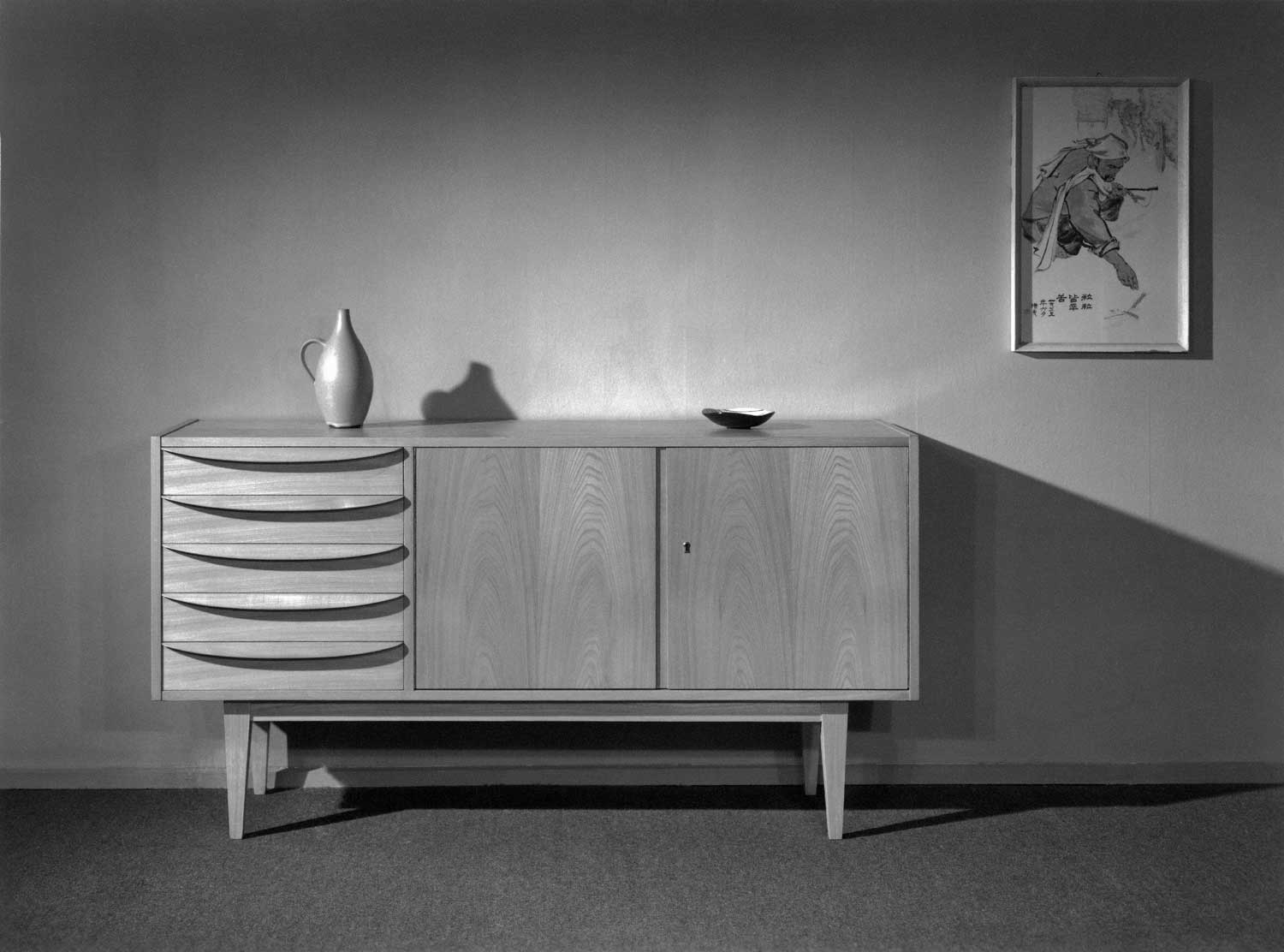Contribution to socialist production
After the Second World War, the Deutsche Werkstätten (German Workshops) were expropriated and continued as a nationally owned company from 1951. In the days of the GDR, the designers from Hellerau also found themselves drawn into the ideological culture war between ‘socialist realism’ and ‘formalism’. It was only after Stalin’s death that the official doctrine could be cautiously circumvented and modern furniture design could be further developed with a return to the style of the 1920s. The 602 type series by Franz Ehrlich from 1956/57 was extremely successful and achieved cult status. The MDW furniture range created by Rudolf Horn ten years later was initially publicly rejected by the GDR leadership, but it was ideal for furnishing the many newly built prefabricated housing units.

Sideboard from the "Type set 602" series, Franz Ehrlich individual furniture that can be completed, 1956-1957.
Sächsisches Staatsarchiv / Hauptstaatsarchiv Dresden, 11764 Deutsche Werkstätten Hellerau Nr. F7208.
Culture war: socialist realism versus formalism
The Deutsche Werkstätten Hellerau (Hellerau German Workshops) had played a pioneering role in combining craftsmanship with sophisticated industrial furniture production since 1900. The fresh start after 1945 also built on this. However, due to their involvement in the Nazi armaments industry, the Deutsche Werkstätten (German Workshops) were expropriated in 1946 and continued to operate as a nationally owned company from 1951. The production and development of new products was thus subject to the objectives of the socialist planned economy and the state cultural policy, which had to follow the USSR specifications. The doctrine of ‘socialist realism’ prevailed there, which was supposed to celebrate the advantages of socialism with a presentation that was coherent as regards content, close to reality, optimistic, and popular. The counter-movement to be combated was formalism, which was described as ‘anti-people’, ‘decadent’, and ‘anti-democratic’. The accusation of formalism included works of subjective, individual expression as well as any form of abstract art, i.e. also the modern serial, functional design of the furniture from Hellerau or Bauhaus. Basically, it was mainly a matter of distancing themselves ideologically from the West – art had therefore once again become a political issue, as it had been during the Nazi era.
The U-turn after Stalin’s death
It was only when the ‘thaw’ set in after Stalin’s death in 1953 that the official doctrine in the GDR could be cautiously circumvented and modern furniture design could be further developed with a return to the style of the 1920s. The Bauhaus members Franz Ehrlich and Selman Selmanagic, a university lecturer in Berlin, worked for Hellerau. The 602 type series by Franz Ehrlich from 1956/57 was extremely successful and achieved cult status. The MDW furniture range created by Rudolf Horn later achieved a comparable status, although the GDR leadership initially publicly rejected it as it was too reduced. It offered the appropriate room furnishings for the mass housing construction with prefabricated, stylised panels that began around 1970 – an idea that Bruno Paul, for example, had already implemented with his wooden houses.
Furniture design was not recognised as a serious artistic achievement in the GDR for a long time, but was included as ‘applied art’ in the V. Deutsche Kunstausstellung (5th German Art Exhibition) in Dresden in 1962 with industrially manufactured products. The design was to “free itself from old, petty-bourgeois habits as well as from modernist formal gimmicks. The prestige of a country’s industrial achievements is not determined by a few exclusive forms, but by the technical and artistic value” (Horst Michel, curator of the exhibition). This marked the beginning of the attempt to link the design language of modernism with the goals of socialism.
Interior fittings as a complex design service
Even in the early days of the Deutsche Werkstätten Hellerau (Hellerau German Workshops), the focus was on designing a room ensemble as spatial art. In the last two decades of the GDR, the idea of complex design became more and more prevalent. It corresponded to the increased demands on mass housing as well as to an expanded concept of culture, which placed the emphasis on the collective interaction of designers and producers and increasingly also on distinctiveness.
